 |
Picks is a monthly sampling of Japan's art scene, offering short reviews of exhibitions at museums and galleries in recent weeks, with an emphasis on contemporary art by young artists. |
 |
 |
 |
1 November 2011 |
 |
| 1 | 2 | |
 |
|
 |
 |
|
|
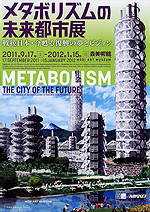 |
 |
 |
 |
| Metabolism: The City of the Future |
| 17 September 2011 - 15 January 2012 |
Mori Art Museum
(Tokyo) |
 |
| "Metabolism" was the name of a movement of architects and designers in the 1960s, among them Kiyonori Kikutake, Kisho Kurokawa, Fumihiko Maki, and Kenji Ekuan, who postulated that buildings and cities must be capable of growing and changing like living organisms -- i.e., "metabolizing." Subtitled "Dreams and Visions of Reconstruction in Postwar and Present-Day Japan," the show illustrates the impact this group and its ideas, influenced in large part by the pioneering work of Kenzo Tange, had on postwar Japanese architecture. The notion of the city as organism has a certain quease-inducing aspect, but in the aftermath of March 11, it may be more relevant than ever. |
|
 |
|

|
 |
 |
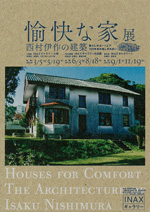 |
|
Houses for Comfort: The Architecture of Isaku Nishimura |
| 1 September - 19 November 2011 |
INAX Gallery
(Tokyo) |
 |
| Nishimura (1884-1963) built three houses in his hometown of Shingu, Wakayama Prefecture. His pioneering effort, erected in 1906, was Japan's first American-style bungalow. His third and finest work, a large residence he built for himself in 1914, is now the Nishimura Memorial Museum. The exhibition is redolent of the liberated mood of Taisho-era Japan and the quest for a new, modern lifestyle reflected in the living spaces designed by Nishimura and others of his generation. |
|
|
 |
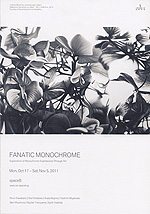 |
|
Fanatic Monochrome: Exploration of Monochrome Expressions through Art |
|
17 October - 5 November 2011
|
|
Osaka Seikei University Gallery Space B
(Kyoto) |
 |
| This exhibition intelligently showcases the artistic use of black and white: the pure contrast of light and shadow, and the underlying essence of chromatic composition in painting, photography and film. Aiming to place the history of monochromatic art in perspective, the show focuses on Japanese artists working in the 21st century in seven areas: graphic design, pen drawings, watercolors, calligraphy, sumi-ink painting, prints, and photography. Featured artists include Shun Kawakami, Kei Hirokawa, Arata Nozima, Yoshimi Miyamoto, Gen Miyamura, Ryuhei Yokoyama, and Syoh Yoshida. |
|
|
|
|
|
|
|

|
 |
 |
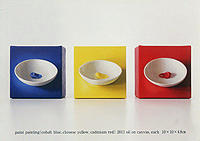 |
|
|
| Ken Matsuyama: Paint Painting |
|
24 August - 5 September 2011
|
Shinjuku Takashimaya 10th Floor Art Gallery
(Tokyo) |
 |
| These are, indeed, paintings of paint. With oils or acrylics, Matsuyama has rendered meticulous portraits of blobs of paint of varying hues -- cobalt blue, chrome yellow, cadmium red -- each posing in a white dish. Though this might sound like something any amateur could do -- i.e., use ultramarine paint to paint ultramarine paint -- it is, of course, not so simple. Other colors are required to achieve nuances of light and shadow and three-dimensionality. In short, blue paint and the color blue are not the same thing. It's an interesting lesson. |
|
|
 |
|
|
| Toeko Tatsuno -- ABSTRACT: Quest for Tomorrow |
|
23 August - 16 October 2011
|
Shiseido Gallery
(Tokyo)
|
 |
| In 1995 Tatsuno became the first woman and youngest artist to have a solo exhibition at the Tokyo National Museum of Modern Art. Of the 20 works in this latest show, only four are in the oil medium for which she is best known; the rest are stone lithographs she produced in Paris this past spring. This reviewer found the switch in medium surprising but then recalled that Tatsuno made her debut in the 1970s with silkscreens of minimalist stripe-and-grid motifs. And indeed, these lithographs are a logical extension of the increasingly abstract-expressionist tableaux she created in the 1980s. |
|

|
 |
 |
|
|
|
|
|
 |
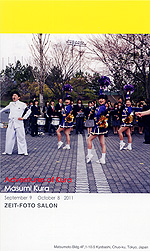 |
 |
|
|
Masumi Kura: Adventures of Kura
|
|
9 September - 8 October 2011
|
Zeit-Foto Salon
(Tokyo) |
 |
| Photographer Kura evinces an intense curiosity about the world around her and a determination to capture it as it really is. The street-scene snapshot is a genre that has the virtue of fostering a unique view of things that can only be acquired "on the road." Unfortunately one does not see many examples of this sort of commitment in photographers of late, and Kura is to be commended for pursuing her muse in this fashion. The seventh installment of her long-running "Pilgrimage to Ise" project, this latest series explores Kyoto and Osaka. |
|
|
|
|
|
|
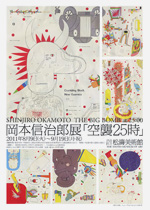 |
 |
|
|
Shinjiro Okamoto: The Big Bomb at 25:00
|
|
9 August - 19 September 2011
|
Shoto Museum of Art
(Tokyo) |
 |
| Okamoto (b.1933) is a self-taught painter who has been exhibiting since the mid-1950s. In the 21st century, he began a series of large works about the wartime fire bombings of Tokyo, using such surreal touches as depicting the bombers as dragonflies. He has also produced work inspired by the September 11, 2001 attacks. His style is clean, colorful and even pop-ish, but the cool sheen effectively highlights the terror of the subject matter. The curving surfaces of the Shoto Museum, designed by Seiichi Shirai, no doubt pose problems for many exhibits, but they are the perfect backdrop for Okamoto's work, providing it with an almost religious ambience. |
|
 |
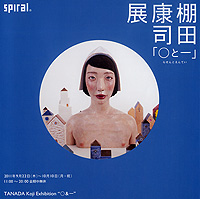 |
 |
|
Koji Tanada Solo Exhibition: " " " |
| 22 September - 14 October 2011 |
Spiral Garden
(Tokyo) |
 |
| Sculptor Tanada's installation makes clever use of the large atrium area at Spiral Garden. Of the seven new works on display, two are pairs: to the rear are "Wind Boy" and "Thunder Girl," alluding to the classic "Gods of Wind and Thunder" of medieval Buddhist art; up in front are "Calm" and "Wave." The latter two figures are subtly twisted into gentle spirals that resonate with the helical shape of the space they occupy. |
|
|
|
|
 |
|
|
 |
|